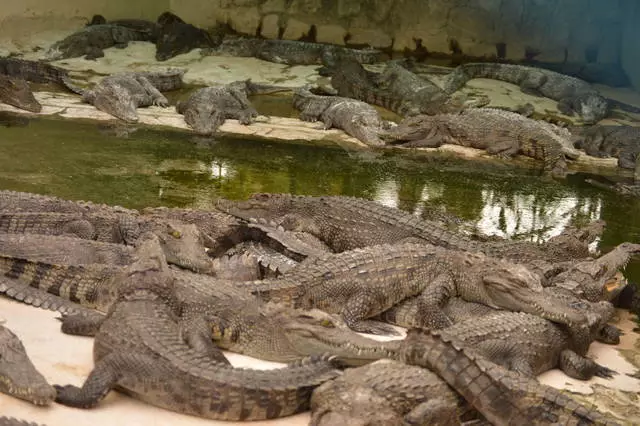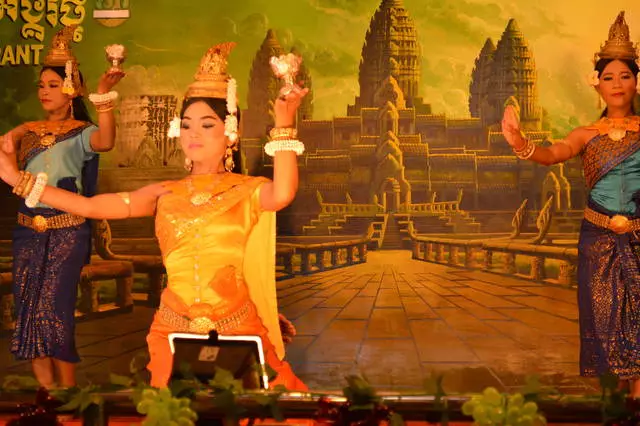The fact that in Siem Rip is going to, in the first (and in the second, and third), see the famous Temple Complex Angkor Wat - it's not a secret to anybody. But what else can you see what excursions to go?
Siem Rip, which is literally translated as "defeated Siam", "victory over Siam" is one of the three cities of Kampucheia (two others - Phnom Penh and Sihanoukville) with the most developed tourist infrastructure, in which, however, it is recommended to stop tourists. Not so far from Siem Ripa spread a huge Lake Tonleshap / Tonle Sap With which our Cambodia study began. Lake Tonlesiap is under UNESCO patronage since 1997 as a biosphere reserve. Local is called Tonleshap Cambodian Sea, for in the rainy season it is, and without it, it increases in size several times and reaches as much as 16,000 square meters. km (the usual area is about three thousand square meters. km). The depth of it varies from 1-2 m in the dry season to 12 m in the rainy season. The name of the Lake Tonleshap is translated from Khmer as "Big Fresh Water", which will cause an attack of a hysterical laughter from anyone who saw the lake in reality. Otherwise, as a local humor, you won't call it - a very controversial name, honestly. Water in a yellow-brown lake and has a clear unhealthy smell, so we say about freshness in this case, perhaps blasphemous.

The village, who was attached to the Lake Tonlesia, which we visited, wears a name Pnom Krom. And the ethnic Vietnamese lives in it already God knows how much time it looks like, since the time of the Vietnamese war. It is not possible to estimate their quantity: by fairly approximate calculations on Tonleep, they found a shelter from 100,000 to 2 million illegal immigrants. There are also victorous local Khmers, but they have a slightly different position due to the status of indigenous people: these comrades are allowed to live on Earth, unlike Vietnamese refugees. Houses of Cambodian (Khmer) here are in high piles in virtually in water, but in the coastal zone. Cause? It is funny and banal - departure from the land tax, because the land is not engaged, which means that it is not worth paying for. The Vietnamese was originally forbidden to hold the land of the Kingdom of Cambodia, but it was allowed to live in the water of the lake, which, you see, looked like a mion. The fact remains a fact: in a prosperous Dopalpotovskaya Cambodia, a stranger could not settle on Earth in the then laws. This was allowed only to those who were born here. How many times have I said that laws need to know well to be able to competently violate them (read: bypass) and never come across. Here, the immigrants argued here that in law it was about the Earth, and there was no speech about the water surface in the legislation. Refugees lost nothing, besides their own chains, and returning to the historical homeland was equated to suicide, and therefore they agreed to the extended conditions, turning into permanent "floats". On Tonlesepa - Boats, Boats, Real Boats! .. Here, on the water, are the mayor's office (or village council? .. I do not know how to call it right), mobile tower, school, lazaret, police station, restaurants and cafes for tourists , bars, market, shops, filling stations. We have even seen a billiard, which, apparently, performs the role of a peculiar local club. On Earth, within reach, on high piles, only the "House of Spirits" is worthwhile, without which no settlement in Southeast Asia is required. During our stay on the lake, we visited the peasant crocodile farm, literally connected by rope ropes with a local floating shop and a small cafeteria. Crocodiles, I will tell you, very fat here, if we compare with those I saw on a large crocodile farm in the very same ripe and in Thailand.
Big (biggest) Crocodile farm in Siem Ripe Deserves much more attention. First of all, I note that the crocodile farm in Siem Ripe is not a banal tourist attraction, but a real farming with a solid in the local estimate of operation. 35 years ago, the company was organized according to the zoo, but after a decade, she passed into private hands and purposefully turned into a commercial enterprise, the purpose of which is not the breeding and multiplication of the crocodile livestock, but obtaining a qualitative final product - crocodile leather. Also, some profit brings a farm for the sale of crocodiles to other countries - for the most part, for culinary needs. The main exporter of young people is currently Vietnam. At the same time, the crocodiles are separated here and are derived, a certain scientific base is supplied under the entire process of "aging" crocodile skin. There are no shows here, and tourists are allowed to be put up for a purely symbolic fee to at least somehow enrich the diet and improve the conditions of reptile content, and simultaneously ensure the expansion and development of production. Here the animal feed will cost you for fabulous money: in Cambodia you will live for them not one day. About a thousand Siamese crocodiles live on the farm in not very spacious enclosures with pools, but still they are in a much more profitable position and an order of more comfortable conditions, rather than the crocodiles of Tonon Sap.

Still worth visiting in the Factory Sheocha in Siem Ripe, Existing at a silk farm, on which all those fodder creatures are patiently removed and carefully hurt. There is nothing to say, I was pretty puzzled by the primitivism as the process of production and the situation. And, again, of course, the factory was showing out, which increases my puzziness several times, for any showing in the world is somewhat embellished. The discovery of such joint ventures intends to distract the population from begging and attracting the youth to normal labor and making money, but the aborigines are not very willingly attaching to production activities. Shelk, produced in Cambodia, less beautiful and significantly rougher than Silk of China, Thailand and India. Yes, and the price of silk products in these three countries is an order of magnitude lower. Even the factory guide was forced to admit that Shallya Cambodia is extremely far from leading world manufacturers that the thread is rude, and therefore the fabric is so gentle as I would like that dyes are not so stable, and therefore molting and loss color can not be avoided. But the process itself is very silking very interesting.
Show dancing Apsar, or APSARA'S DANCE . Apsears - Nymphs or Divine Heavenly Dancers, Characters of Indian and Buddhist Mythology. In fact, they are heavenly virgin beauty. The movements of the dancing girls are very slow and smooth, robes are breathtakingly luxurious, and each dance is a kind of scene from the life of the gods, drawn from mythology, or the plot of Khmer history. There are a lot of gold (golden color) in the decoration of the performers: it is both suitable hats, crowns, and bracelets, and belts, and gold flowers in their hands, and bubber on barefoot legs. Of course, girls are dancing under national Khmer music, which is somewhat tiring in large quantities. This is what really admires, so fantastic bends of the hands and the mind incomprehensible finishing of fingers - this skill girls learn from the very childhood, as well as the abdominal dance in Arab countries.

Here is a brief excursion for the main tourist paths of Siem Ripa.
